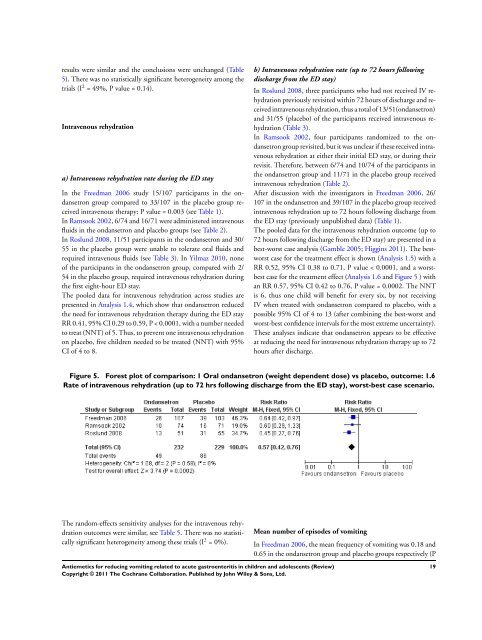Antiemetics for reducing vomiting related to acute ... - Update Software
Antiemetics for reducing vomiting related to acute ... - Update Software
Antiemetics for reducing vomiting related to acute ... - Update Software
You also want an ePaper? Increase the reach of your titles
YUMPU automatically turns print PDFs into web optimized ePapers that Google loves.
esults were similar and the conclusions were unchanged (Table<br />
5). There was no statistically significant heterogeneity among the<br />
trials (I 2 = 49%, P value = 0.14).<br />
Intravenous rehydration<br />
a) Intravenous rehydration rate during the ED stay<br />
In the Freedman 2006 study 15/107 participants in the ondansetron<br />
group compared <strong>to</strong> 33/107 in the placebo group received<br />
intravenous therapy; P value = 0.003 (see Table 1).<br />
In Ramsook 2002, 6/74 and 16/71 were administered intravenous<br />
fluids in the ondansetron and placebo groups (see Table 2).<br />
In Roslund 2008, 11/51 participants in the ondansetron and 30/<br />
55 in the placebo group were unable <strong>to</strong> <strong>to</strong>lerate oral fluids and<br />
required intravenous fluids (see Table 3). In Yilmaz 2010, none<br />
of the participants in the ondansetron group, compared with 2/<br />
54 in the placebo group, required intravenous rehydration during<br />
the first eight-hour ED stay.<br />
The pooled data <strong>for</strong> intravenous rehydration across studies are<br />
presented in Analysis 1.4, which show that ondansetron reduced<br />
the need <strong>for</strong> intravenous rehydration therapy during the ED stay<br />
RR 0.41, 95% CI 0.29 <strong>to</strong> 0.59, P < 0.0001, with a number needed<br />
<strong>to</strong> treat (NNT) of 5. Thus, <strong>to</strong> prevent one intravenous rehydration<br />
on placebo, five children needed <strong>to</strong> be treated (NNT) with 95%<br />
CI of 4 <strong>to</strong> 8.<br />
b) Intravenous rehydration rate (up <strong>to</strong> 72 hours following<br />
discharge from the ED stay)<br />
In Roslund 2008, three participants who had not received IV rehydration<br />
previously revisited within 72 hours of discharge and received<br />
intravenous rehydration, thus a <strong>to</strong>tal of 13/51(ondansetron)<br />
and 31/55 (placebo) of the participants received intravenous rehydration<br />
(Table 3).<br />
In Ramsook 2002, four participants randomized <strong>to</strong> the ondansetron<br />
group revisited, but it was unclear if these received intravenous<br />
rehydration at either their initial ED stay, or during their<br />
revisit. There<strong>for</strong>e, between 6/74 and 10/74 of the participants in<br />
the ondansetron group and 11/71 in the placebo group received<br />
intravenous rehydration (Table 2).<br />
After discussion with the investiga<strong>to</strong>rs in Freedman 2006, 26/<br />
107 in the ondansetron and 39/107 in the placebo group received<br />
intravenous rehydration up <strong>to</strong> 72 hours following discharge from<br />
the ED stay (previously unpublished data) (Table 1).<br />
The pooled data <strong>for</strong> the intravenous rehydration outcome (up <strong>to</strong><br />
72 hours following discharge from the ED stay) are presented in a<br />
best-worst case analysis (Gamble 2005; Higgins 2011). The bestworst<br />
case <strong>for</strong> the treatment effect is shown (Analysis 1.5) with a<br />
RR 0.52, 95% CI 0.38 <strong>to</strong> 0.71, P value < 0.0001, and a worstbest<br />
case <strong>for</strong> the treatment effect (Analysis 1.6 and Figure 5 ) with<br />
an RR 0.57, 95% CI 0.42 <strong>to</strong> 0.76, P value = 0.0002. The NNT<br />
is 6, thus one child will benefit <strong>for</strong> every six, by not receiving<br />
IV when treated with ondansetron compared <strong>to</strong> placebo, with a<br />
possible 95% CI of 4 <strong>to</strong> 13 (after combining the best-worst and<br />
worst-best confidence intervals <strong>for</strong> the most extreme uncertainty).<br />
These analyses indicate that ondansetron appears <strong>to</strong> be effective<br />
at <strong>reducing</strong> the need <strong>for</strong> intravenous rehydration therapy up <strong>to</strong> 72<br />
hours after discharge.<br />
Figure 5. Forest plot of comparison: 1 Oral ondansetron (weight dependent dose) vs placebo, outcome: 1.6<br />
Rate of intravenous rehydration (up <strong>to</strong> 72 hrs following discharge from the ED stay), worst-best case scenario.<br />
The random-effects sensitivity analyses <strong>for</strong> the intravenous rehydration<br />
outcomes were similar, see Table 5. There was no statistically<br />
significant heterogeneity among these trials (I 2 = 0%).<br />
Mean number of episodes of <strong>vomiting</strong><br />
<strong>Antiemetics</strong> <strong>for</strong> <strong>reducing</strong> <strong>vomiting</strong> <strong>related</strong> <strong>to</strong> <strong>acute</strong> gastroenteritis in children and adolescents (Review)<br />
Copyright © 2011 The Cochrane Collaboration. Published by John Wiley & Sons, Ltd.<br />
In Freedman 2006, the mean frequency of <strong>vomiting</strong> was 0.18 and<br />
0.65 in the ondansetron group and placebo groups respectively (P<br />
19












